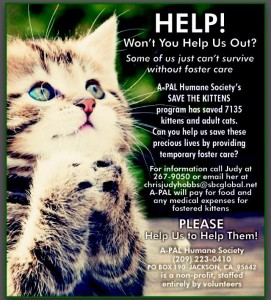
A-Pal Humane Society has a surprisingly long history in Amador County. In 1978 a group of animal loving Amador County residents created the organization with the goal of promoting the humane treatment of animals in Amador County. You can read about their many accomplishments here. Their bottom line is amazing: A-PAL Humane Society has worked with shelter staff and volunteers to move the shelter intake from 2400 animals annually with a save rate of only 15% in 1988, to 1558 animals in 2013 with a save rate of 87%. Pretty impressive!
They have lots of special programs and there are many volunteer opportunities. One thing we think is especially cool is that volunteers actually work at the shelter socializing the animals, walking the dogs, etc. They also have volunteers who foster cats and kittens in their homes. Some of their programs include low cost spay/neuter, community cats and helping animals with special needs.

